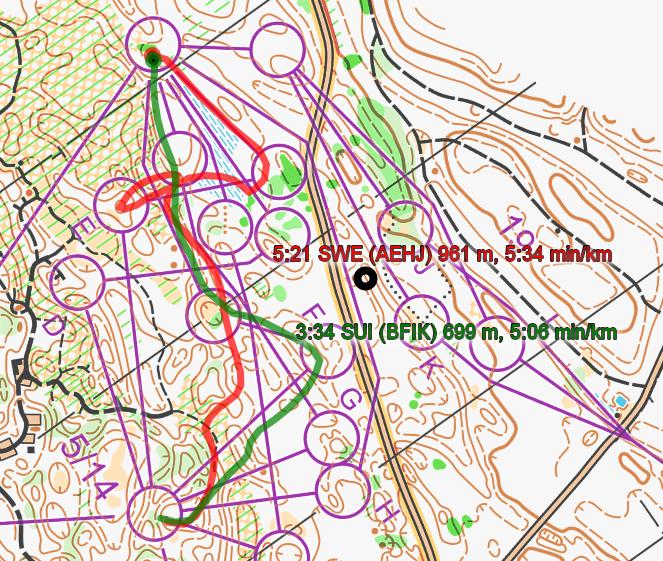
In many ways the men’s World Championships relay at WOC 2015 was decided already at the first real forking at the first leg – to the 6th control. In this quite easy terrain, the runners did very few significant mistakes.
The exception was the first leg runners who had trouble with the forking with the high pressure and high speed at the start of the relay – and the last leg runners who had trouble with the high pressure in the decision phase approaching the finish.
First leg: Hertner takes on the challenge
The Swiss first leg runner Fabian Hertner was the only of the top teams who mastered this challenge. Above you see Hertner’s route compared to Swedish Jonas Leandersson who ran to the wrong forking and lost significant time. Similarly below is a comparison with Norwegian Øystein Kvaal Østerbø who did a similar – but less severe mistake. Finland was another team doing a similar mistake here – so did Russia and several other of the top favourites. France did, however, master the forking in an excellent way – this was the key to their success in the relay. Several of the non-favourite teams followed Hertner (Belarus, Austria), though.
The below graphical split time comparison (only showing common controls) shows the development at the first leg. Note how several teams lose time at the 3rd split (which is the control shown above) – whereas France’s Vincent Coupat keeps up. France does lose time through the forking the second time though. Great Britain’s Scott Fraser has also problem in the first forking, but runs a fantastic last part of the leg, thus still putting Great Britain in a good position.
Second leg: “Easy job” for Daniel Hubmann
Out on the second leg Daniel Hubmann had got the position he needed: Alone in the lead with nobody seeing his back. Hubmann made no significant mistakes – and neither did the other top favourites. The only exception being French Lucas Basset who lost around 20 seconds on the control before the big forking, letting Britain’s Graham Gristwood slip past.
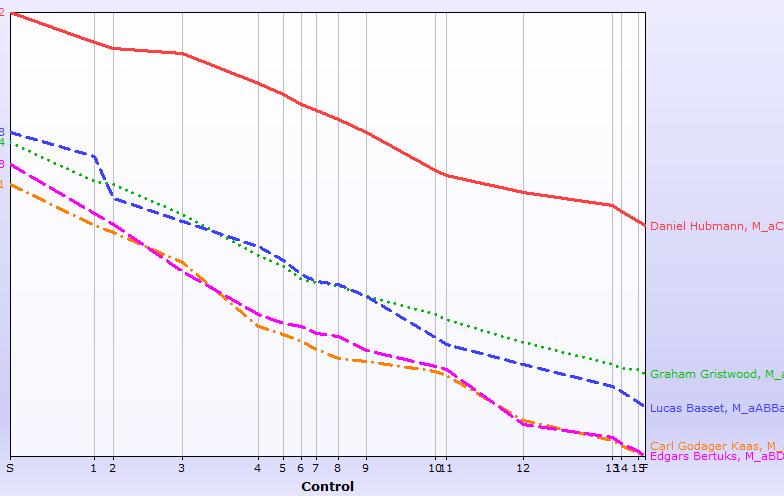

Third leg: Matthias Kyburz wraps it up
At the head of the relay there was no trouble for Switzerland’s Matthias Kyburz. He could run unopposed from his competitors. The real action was further back where Norway’s Magne Dæhlie fought against France and Great Britain. Here France’s Frederic Tranchand made two small mistakes – which was enough for Norway to slip past. Great Britain’s Ralph Street simply could not keep up with the Norwegian’s speed.
Here you see the first decision point. France makes a 15-20 second mistake (checking control J although this was not his control). This is enough for Dæhlie to get so close that he gets up to the back of Tranchand.
The next decision is the 22nd control. Here Tranchand makes a small 10-15 second mistake – enough for Dæhlie to get the decisive gap.
Maps and GPS-tracking
WOC Relay 2015 Men - leg 3

» See map in omaps.worldofo.com
WOC Relay Men leg 2

» See map in omaps.worldofo.com
WOC Relay Men leg 1

» See map in omaps.worldofo.com
Results
| 1st | 101:40 | 102 | Switzerland | SUI | 33:22 | (1st) | 33:37 | (1st) | 34:41 | (3rd) | Fabian Hertner/Daniel Hubmann/Matthias Kyburz |
| 2nd | 103:30 | 104 | Norway | NOR | 35:11 | (13th) | 34:13 | (3rd) | 34:06 | (1st) | Oystein Kvaal Osterbo/Carl Godager Kaas/Magne Daehli |
| 3rd | 103:52 | 103 | France | FRA | 34:38 | (6th) | 34:16 | (4th) | 34:58 | (4th=) | Vincent Coupat/Lucas Basset/Frederic Tranchand |
| 4th | 104:29 | 107 | Great Britain | GBR | 34:44 | (8th) | 33:49 | (2nd) | 35:56 | (10th) | Scott Fraser/Graham Gristwood/Ralph Street |
| 5th | 105:25 | 106 | Czech Republic | CZE | 34:40 | (7th) | 35:31 | (9th) | 35:14 | (8th) | Jan Prochazka/Jan Sedivy/Vojtech Kral |
| 6th | 105:39 | 109 | Estonia | EST | 34:49 | (9th) | 35:51 | (12th) | 34:59 | (6th) | Sander Vaher/Lauri Sild/Timo Sild |
| 7th | 106:28 | 101 | Sweden | SWE | 36:17 | (17th) | 35:13 | (7th) | 34:58 | (4th=) | Jonas Leandersson/Olle Bostrom/Gustav Bergman |
| 8th | 106:31 | 118 | Lithuania | LTU | 35:15 | (14th) | 36:06 | (15th) | 35:10 | (7th) | Vilius Aleliunas/Simonas Krepsta/Jonas Vytautas Gvildys |
| 9th | 106:59 | 120 | Bulgaria | BUL | 34:37 | (5th) | 36:46 | (16th) | 35:36 | (9th) | Kiril Nikolov/Ivaylo Kamenarov/Ivan Sirakov |
| 10th | 107:15 | 108 | Austria | AUT | 33:51 | (3rd) | 37:21 | (18th) | 36:03 | (11th) | Gernot Kerschbaumer/Helmut Gremmel/Robert Merl |
 World of O News
World of O News
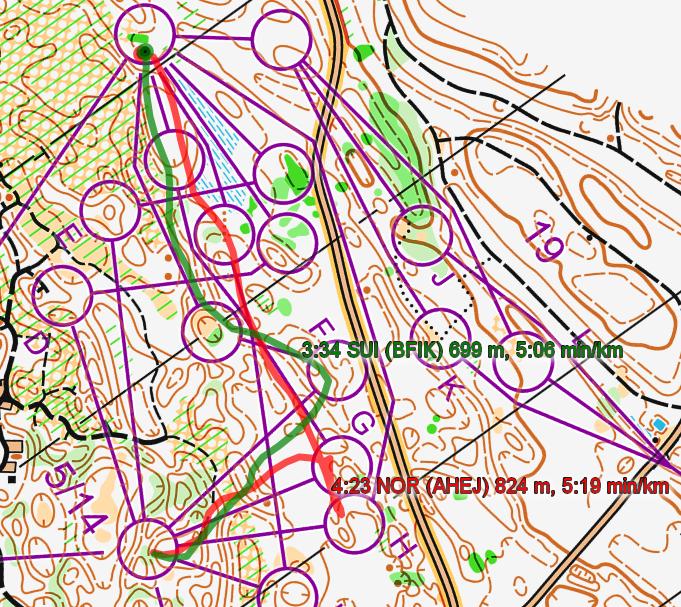
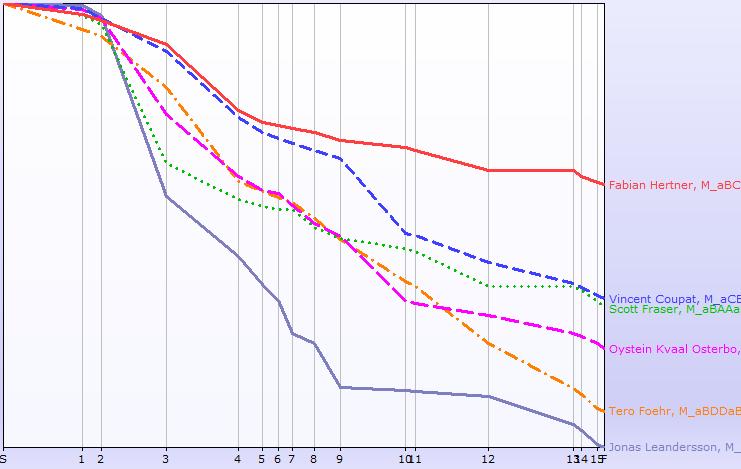
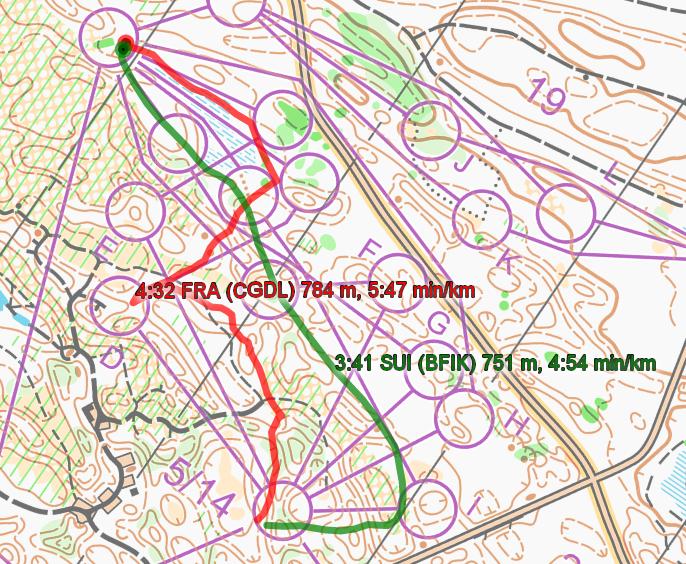

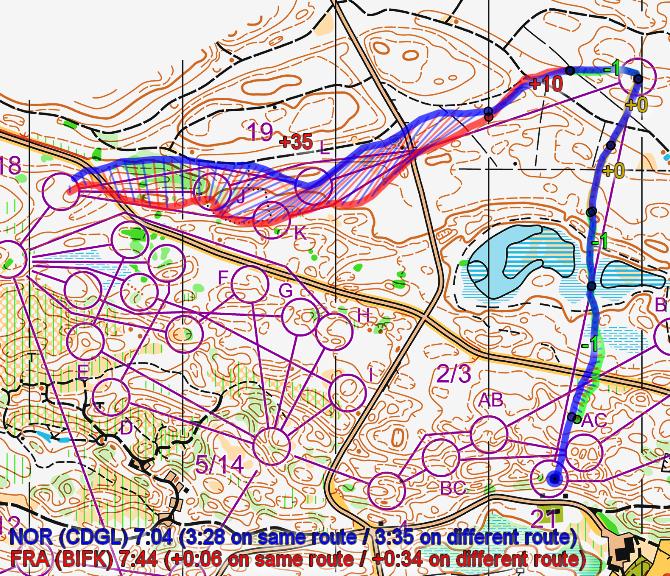
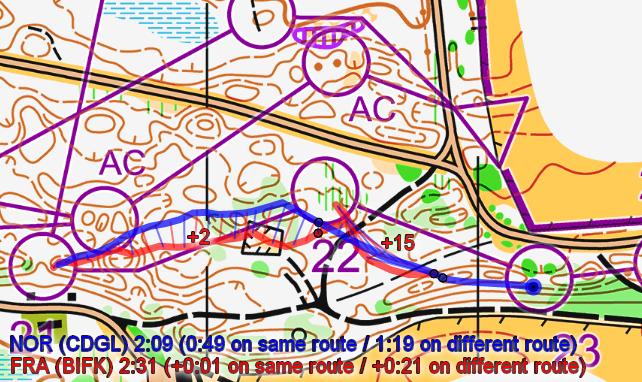




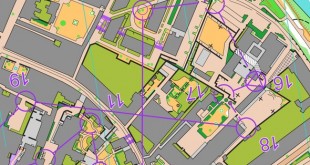
“In many ways the men’s World Championships relay at WOC 2015 was decided already at the first real forking at the first leg – to the 6th control.”…..really?! Didn’t the Suisse guys still have to run 2 3/4 legs at this point (and they did this very well.)
You don’t win a relay on the first leg, but you can lose one. And that was my point here; Norway and Sweden practically lost the possibility for gold in this relay by doing these mistakes early on in the relay. Of course Hertner on the rest of the leg and the Swiss men on the second and third leg had to run well, but as they run as well as they did, Norway and Sweden had already lost their winning chance after 1/4 of the first leg due to the great performance of Switzerland in the rest of the relay.
@James Tullie: You are obviously correct, the swiss ran a nearly perfect relay with 1,1,3 as their individual leg results, and Matthias Kyburz only lost about 35 sec to Magne Dæhlie even though he slowed down significantly in the finish chute.
I still think Graeme did the best course setter job for any modern WOC relay, with enough forking to force nearly every group to split up very quickly indeed. Bravo!
@Terje: A great course from an athlete point of view, yes, but I am not sure if that course worked well on TV. At least not the way it was presented (and then I am not talking about the GPS that didn’t work).
Unfair forking?
I realized this evening that if all the 720 different combinations were selected with equal probability then you would have an unfair forking system: I.e. the 6 alternatives were named D-E-F-G-H-I, so if one team got D and E for one runner, then F and G for a second and finally H and I for the last, each runner would have a big advantage in the second time through the phi loop since their second fork would be quite close to the first, right?
If another team got D and G, E and H and F and I then that would maximize the forking difference for each runner, making it significantly harder on the second half.
In order to avoid this, the course planner (Graeme) would have had to either fix the available combinations so that only 3 different pairings were used, but allowing both orderings within each pair, or he must have found some other method to avoid this problem.
Using the 3 pairs method would still give a 6-way fork, but a team that got the same combination as the swiss would stay with them for both rounds of the phi.
@Terje: There was an intricate plan behind the forkings, and only a certain amount of forkings were used (I think it was 9 or maybe 18?). In Winsplits you can take a look at all forking combinations used and who used them.
@Jan: OK, thanks, I’ll check out the winsplits data!
I assumed Graeme had indeed limited himself to a mathematically fair subset of the possible forkings, he already hinted that the full set was too complicated for his course planning sw. :-)
With a 3 + 6 + 3-way simplified forking setup you still get 54 different combinations on the first leg, i.e. sufficient to make sure no two runners had the same course all the way. If the first 3-way split was combined with the last you get down to your suggested 18, and that would make it possible to micro-adjust the expected running times so as to make them extremely close to identical.
I was kind to the printers, there were only 18 variations used (plus a different last lap). By control 6 the course was already split 18 ways. It meant that you could follow a team 18 places ahead at the last WOC: I though that was unlikely to affect the results. It was rather super that Belarus came back in the lead on the first leg (just passed on the finish line) – and they didn’t even have the same forkings as the Swiss.
Thanks for the excellent analysis Jan, feedback really helps us planners too.